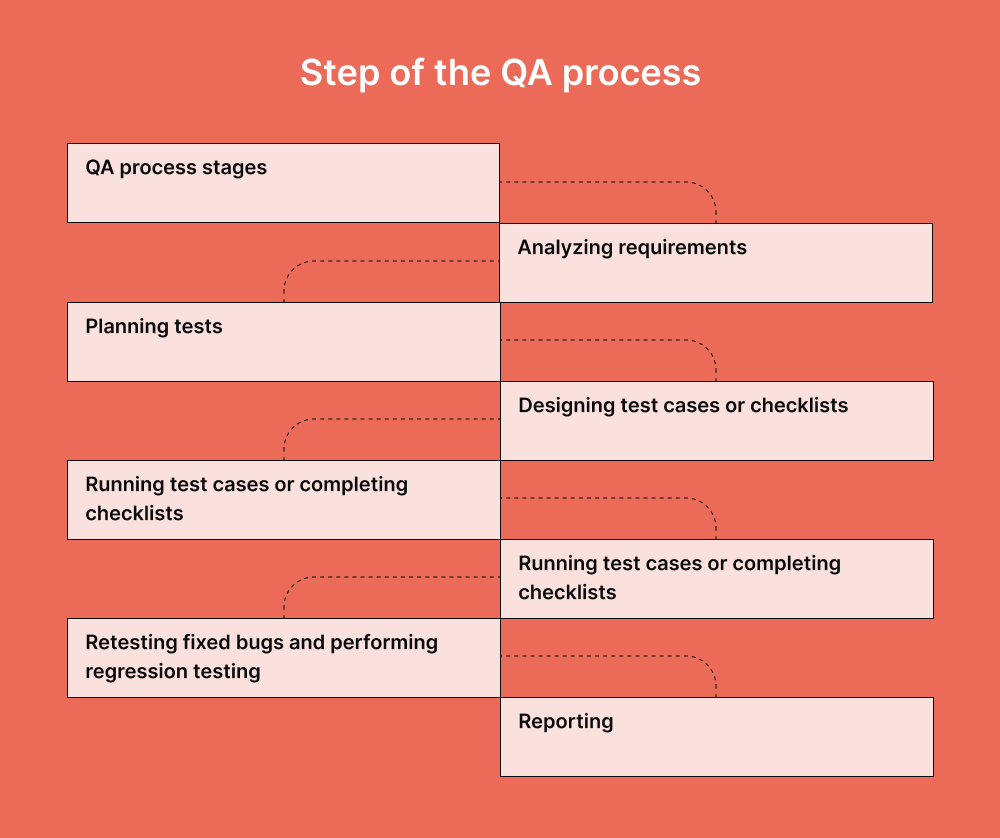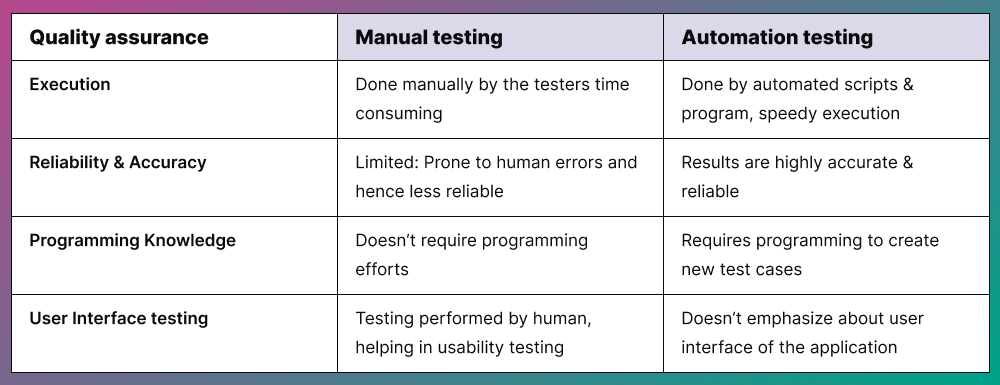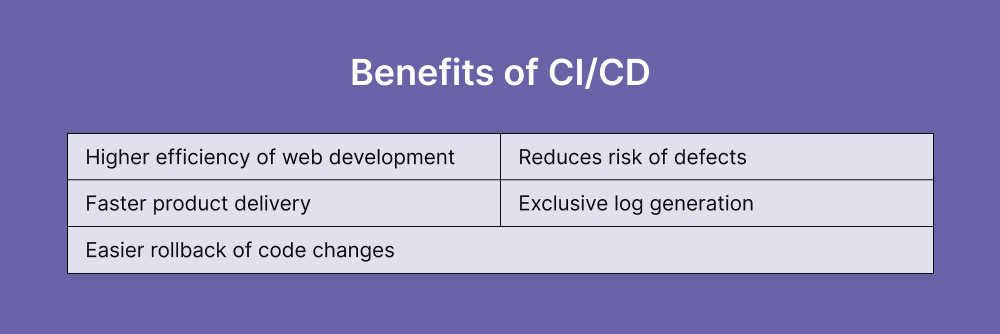Best practices for QA testing
This article explains some of our advice for the best practices in QA testing. We'll introduce QA testing, dive into our 9 best practices, and talk a little bit about crowdtesting. If you're interested in the subject, subscribe via our form below!
QA testing by the numbers
Quality software is the bedrock of a successful startup, and its absence can lead to colossal financial setbacks. In the US alone, poor-quality software cost organizations a staggering $2.8 trillion in 2018. Surprisingly, many companies prioritize expansion over perfection, often overlooking the substantial impact of software glitches. For instance, over a third of smartphone users uninstall an app encountering bugs.
In software development, the debate between improving existing features and releasing new ones often favors the latter. However, this distinction needs to be revised. Opting for quick wins by compromising software quality leads to significant future losses. It may be tempting to release new features quickly to meet customer demands and gain more market share.
However, this approach can lead to defects and technical debt, which will eventually become apparent. Sacrificing quality can result in higher costs, lower user adoption, and delayed feature delivery as technical debt slows progress. Therefore, following best practices for QA testing is essential to ensure sustained success in your daily work.
What is QA testing?
QA testing is the procedure developers use to validate and ensure the quality of a software product or service before its release to customers. Unlike product creation, QA testing assesses the final product's quality and achieved outcomes.The typical activities in QA testing include:
- Identifying and rectifying errors, bugs, and redundancies
- Confirming logical flow
- Ensuring a seamless User Interface (UI) and User Experience (UX)
- Addressing unexpected software flaws and
- Validating that developers adhere to customer requirements.
The primary objective of QA testing is to ascertain if a product aligns with customer requirements, and the secondary goal is to ensure developers address any issues before launch.
The broader aim of QA testing is to enhance the quality and efficiency of the software development process, seeking to meet industry-best quality standards. While QA testers were traditionally involved near the end of the development cycle, modern practices encourage collaborative work with software developers throughout the process, ensuring ongoing suggestions and implementations for optimal solutions. A QA tester or analyst is motivated by the commitment to deliver the highest-quality product to customers.
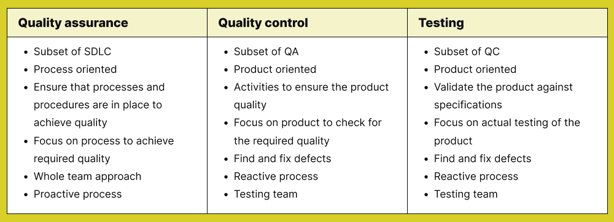
What's a typical example of a QA process?
The QA process is essential for evaluating whether a product meets specified requirements. Although software testing approaches may vary among companies, the fundamental stages remain consistent.
- Analysis of requirements: QA analysts scrutinize project requirements, gaining clarity on their involvement parameters early in the development cycle. This analysis is pivotal, setting the groundwork for effective quality control.
- Planning: QA professionals initiate the test planning phase once project requirements are understood. They define the scope of work, devise a project-specific testing strategy, and outline the QA approach for each software engineering cycle stage, specifying the required testing types and tools.
- Test case development: Test cases encompass actions performed on a system to verify its correct functioning. These cases ensure that software features comply with guidelines. Developing test cases involves creating step-by-step processes for each testing sequence, encompassing both manual and automated testing methods.
- Test execution: This phase involves implementing prepared test cases, assessing the disparities between expected and actual results, and documenting bugs, errors, and issues. QA testers may create sub-tests to address these problems, presenting final results to the team for further action.
- Verification: Following the resolution of identified issues, verification entails retesting the product. This involves regression testing and analysis to confirm the successful resolution of identified bugs and to identify any new issues, ensuring optimal product functionality.
Documentation and reporting: The final stage includes creating a document detailing all conducted tests, their outcomes, and insights into detected errors and anomalies. This comprehensive document chronicles the entire testing process, serving as a reference for future product testing cycles.
Documentation and reporting: The final stage includes creating a document detailing all conducted tests, their outcomes, and insights into detected errors and anomalies. This comprehensive document chronicles the entire testing process, serving as a reference for future product testing cycles.
How to get started with QA testing
When numerous bugs plague an application, it can lead to user frustration, diminished customer satisfaction, and a potentially adverse impact on your market standing. Thus, collaboration between developers and QA engineers becomes crucial to prevent bugs from escaping into production.
To develop and deliver high-quality software, maintaining uncompromised standards throughout the app testing stages is imperative.
With an increasing user base, exercising heightened caution in QA becomes even more essential. Follow the steps below to establish an effective QA process for testing your software you should:
- Incorporate QA testing into every phase of the software development lifecycle. Early involvement of QA teams increases the likelihood of identifying issues and implementing corrective measures.
- Implement the DevOps model, a fusion of development and operations teams to accelerate the development and delivery of applications. Departing from traditional processes, a DevOps model offers significant competitive advantages, reducing failure rates and enhancing time-to-market.
- Clarity is critical in QA testing to achieve swift results within tight deadlines. Testers must clearly understand a software product's final deliverables to be effective. Furthermore, transparency allows other teams to monitor and derive insights from the testing process.
- Enable results-oriented QA testing, which directs QA teams to concentrate on the specific business goals of a software product. This strategy is centered on creating a faster and more dynamic testing environment, enabling testers to allocate resources effectively and deliver optimal outcomes.
9 best practices for QA testing implementation
These best practices in QA can contribute to maintaining the highest standards in product delivery.
1. Combine test automation and manual testing
Your QA testing should include both automated and manual testing. It is crucial to determine the most relevant type of test for each aspect and stage of the product. Manual testing allows businesses to cover a wide range of conditions and scenarios. The QA testers' feedback regarding the app's experience and feel will prove invaluable.
Manual tests are preferable for exploratory testing, usability testing, and ad hoc testing. Ideally, testers should perform manual tests that represent different end-user profiles and use a wide range of devices and operating systems.
To save time, you can supplement manual testing with frequent automated tests.
In addition, automation emerges as the most suitable solution when conducting white box testing, load tests, and other performance testing.
Which tests should you automate?
The goal is to automate any test that requires repeated execution. Automated tests are practical and reliable and will help you ensure the app performs adequately from a technical standpoint.
Still, automation won't be a good fit for all your testing needs. You can supplement the manual testing performed in-house with crowdtesting. Using this approach, you can test your product on a much larger scale and be time-efficient.
2. Include agile methodologies
Embracing a methodology that integrates testing into a series of brief development cycles is another valuable QA practice you should consider. Agile methodologies align well with the development of mobile apps, where short development cycles are common, and users expect high functionality, quality, and frequent updates.
In agile methodologies, QA testing is seamlessly woven into the design and development processes rather than being a distinct phase. Test outcomes are directly integrated into the ongoing design and development procedures, establishing quality as a fundamental guiding principle.
How does it work?
This collaborative approach requires designers, developers, the QA team, and sometimes even users to communicate or work together. Your teams will go through a short design or development cycle, followed by a targeted quality control and testing phase for the new feature that was just added.
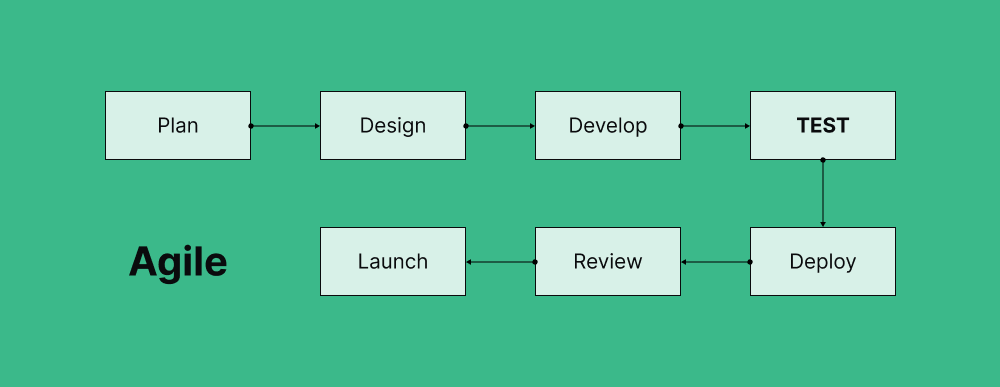
Additional regression testing, security testing, and stress testing can be undertaken as needed. The outcome of this phase will determine what happens during the subsequent design or development cycle.
What’s the benefit of the agile approach?
Leveraging automation will keep things moving once you adopt this approach. Test automation speeds up the targeted testing phases. It helps you move on to the next development cycle in hours or days.
You will need to schedule manual tests after some essential design or development cycles to incorporate feedback regarding the app's user experience and other vital aspects. Then, you will need to create a framework for reviewing and using the data generated during the short testing phases.
However, it's not enough to undergo functional testing - you need to incorporate feedback into the design and development process as early as possible.
3. Write great test cases
Is it advisable for developers to write tests? On one side, the agile methodology emphasizes ownership, suggesting that involving developers in the test case creation process will make quality assurance part of their responsibilities. On the flip side, developers who author tests may develop biases, potentially crafting code that merely satisfies the test without adhering to broader quality standards or unintentionally creating tests with limited coverage. For this reason, some teams create a test plan but then rely on outsourcing the process or handing it over to dedicated QA engineers. For example, you can follow the next steps:
Test case suite cohesion
Even though each test case should have a narrow focus, there should be cohesion in your test case suite, adapted to your project's scale.
Customization and execution in a different environment
Customize and execute test cases in an environment different from the one used for development. Base each test with expectations that are clear, and that can result in a measurable outcome.
Break down test cases
Break down each test case into a series of concise steps, telling you whether or not a feature works. Consider the creation of a test case as a sequence of actions linked to a question. When an action is executed, the automated test or human testers should respond to a straightforward question to evaluate the success of the action.
Clear instructions for testers
The instructions written for each test case should give testers a clear understanding of what they are expected to do. Enhance efficiency and achieve superior results by providing test cases, instructions, and tutorials that are clear and less prone to misinterpretation.
Testing tools are available to make this even more accessible. In an Agile or DevOps workflow, software development teams must balance the need for rapid releases with the need for thorough testing. Regression testing can be a bottleneck in this process if not managed properly. However, there are ways to regression test effectively without slowing down the development process. In this section, we'll explore how you can regression test in an Agile or DevOps workflow without it becoming a bottleneck.
4. Integrate Continuous integration and Continuous delivery
Continuous integration (CI) and continuous delivery (CD) strategies are used in software development and complement the agile methodology.
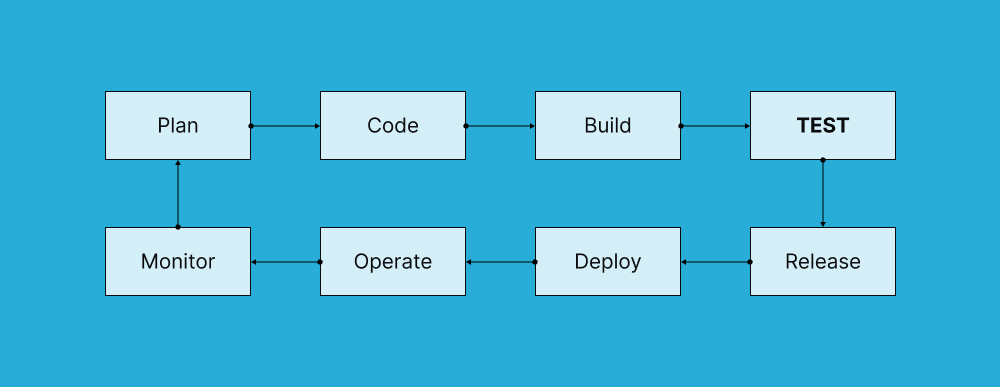
Without CI and CD, developers split up their work and assemble different code segments late in the development cycle. This may result in a lack of cohesion, compatibility, and issues with the interaction of various code segments.
How does CI work?
With continuous integration, the code is kept in a central repository. Developers work on making minor changes to the code and uploading small sections of code to the central repository regularly. Integrating quality management into this methodology involves conducting a series of tests with each code update. While testing the new segments is essential, regression testing is also crucial to assess how changes impact the product's main features.
How does CD work?
Continuous delivery enables the regular release of new iterations of your product, providing a swift and efficient method for addressing bugs and issues that impact the user experience.
The key is incorporating user feedback into your CI and CD processes to quickly address issues and release a new and improved product version. Again, you will have to incorporate testing in your process, for instance, by having crowd testers perform usability tests before a new major version of your product is made available to users.
5. Prioritize communication as a fundamental principle
This principle extends across the entire software development team, particularly on the testing team. The significance lies in the continuous nature of testing, spanning various stages of development.
When the entire team is well-informed about the testing process, it fosters collective involvement in testing endeavors. Regular communication between testers and software engineers is essential for a comprehensive understanding of the ongoing tasks. As a result, it diminishes risks and vulnerabilities and enhances the ultimate outcomes.
6. Elevate the focus on security in testing
While testing practices aim to enhance a software solution for superior performance, they are important in fortifying the product against digital threats. Incorporating security-driven tests, such as penetration tests, is essential.
Adopting a mindset akin to a malicious actor and attempting to hack your own program provides valuable insights into your software's vulnerabilities. This proactive approach not only identifies weaknesses but also facilitates the development of more robust strategies to strengthen the system's overall security.
Global App Testing can help
Global App Testing has incorporated secure product development procedures. Every REST and GraphQL request undergoes layers of load balancers and reverse proxies, with internal API endpoint authentication strictly enforced. Furthermore, routine external web penetration tests are conducted, complemented by a bug bounty program. This comprehensive approach ensures the prompt identification and resolution of any vulnerabilities that may have been overlooked during development.
Global App Testing has successfully concluded its ISO 27001 audit, affirming our adherence to the highest global security standards. By implementing robust processes and policies, we prioritize data security, integrity, and availability.
7. Select the appropriate testing and management tools
In the current era, we benefit from an abundance of tools designed to facilitate our work, and this holds true for software testing, a domain rich in diverse testing and management platforms. While the extensive range of options is advantageous, it can also be overwhelming.
Therefore, we recommend thoroughly analyzing the available tools to comprehend their advantages and disadvantages. You should carefully consider factors such as ease of use, cost, integration with existing tools, and scalability to make an informed decision about selecting the most suitable tool for your needs.
Many useful tools are available to help you create automated test cases, manage your tests, and integrate them into a SCRUM or Kanban workflow.
For example, GAT integrates with:
- Jira: Integrate GAT into Jira for easy tracking and action on bug fixes.
- GitHub: Simplify bug tracking and fixing by integrating GAT into your GitHub processes.
- Azure DevOps: Combine crowdtesting with agile DevOps using our Azure DevOps integration.
- Pivotal Tracker: Enhance productivity with Pivotal Tracker and integrated crowdtesting.
- Trello: Visualize app bugs in Trello for easy collaboration on solutions.
- Sprintly: Utilize Sprintly's bug-tracking dashboard through seamless integration.
- DoneDone: Integrate GAT with DoneDone for bug tracking and customer support synergy.
- Basecamp: Add new bugs to your Basecamp project for quick team collaboration.
- Asana: Assign new bugs efficiently by integrating GAT with Asana's productivity platform.
8. Use crowdtesting
Crowdtesting can significantly improve the scalability of your testing process by accessing a large pool of QA testers within a short period. You can get results in hours with hundreds of QA testers working simultaneously on various devices, conducting cross-browser testing, and checking different operating systems for software compatibility. You should balance in-house testing, crowdtesting, and automated testing for optimal outcomes.
Consider using Global App Testing
GAT is the leading end-to-end solution for web and app testing. Through a fusion of crowdtesting and intelligent automation, you can anticipate swift resolutions to your QA challenges. With the ability to conduct tests in more than 190 countries and a global team of over 90,000 professional testers, GAT is the preferred choice for leading enterprises, counting Microsoft and Facebook among its clients.
Offering rapid testing and scalability that is adaptable to any timeframe or project, GAT is a trusted partner for diverse testing needs.
9. Incorporate software QA testing best practices
Incorporate the following software QA testing best practices into your daily routine for successful testing:
Focused testing:
- Test one aspect at a time with clear objectives. With each test, focus on a specific feature, user interface aspect, or security concern.
Understanding test types:
- Familiarize yourself with various testing types, such as load testing and user acceptance testing (UAT). Understand the distinctions and know how to effectively apply them.
Regression testing:
- Implement regression tests because testing a key feature once is insufficient. New additions to the code repository may impact features that previously passed tests.
Bug reporting and tracking:
- Establish a systematic approach for reporting and tracking bugs. Decide on bug reporting tools and the required data. Consider using an open-source bug-tracking tool or developing one tailored to your workflow.
Analytics utilization:
- Leverage analytics to decide on QA metrics to track. Keep comprehensive records of every test conducted, utilizing this data to identify potential bug-prone areas. Develop new tests based on this information.
Environment considerations:
- Select the appropriate environment for tests, covering various scenarios such as different devices, operating systems, and user profiles.
Unit and integration tests:
- Use unit tests to isolate each component of your application. Integration tests assess how well each subsystem collaborates. You can alos run unit tests in parallel to save time, ensuring individual components function correctly before moving on to integration tests.
UI attention:
- Pay close attention to the user interface (UI) by employing functional tests conducted by human testers. These tests simulate end-to-end scenarios, providing insights into the app's UI. Consider addressing issues identified during unit and integration tests before proceeding.
QA testing: a wrap-up
These best practices for QA testing should be applied from the discovery stage through software release and subsequent phases, including maintenance and support.
However, it's not necessary to implement all these practices in a single project. A skilled QA team can adeptly choose the right approach and tools tailored to meet specific customer requirements, ensuring a seamless workflow and exceptional quality in the final product.
15 tips to help you write functional test cases
Crafting functional test cases involves more than just a rudimentary understanding of the software. It requires detailed knowledge, meticulous attention to detail, and the foresight to identify potential challenges. The goal is not merely to fulfill a checklist of requirements but to construct a dependable framework that guides the development of reliable and user-focused software. In this article, we'll explore 15 tips to write functional test cases, a skill essential for any software tester or QA professional striving for excellence in software testing.
QA testing FAQs
What is QA testing?
Quality Assurance (QA) testing is a systematic process to ensure software meets specified requirements and functions without defects. It involves various testing methods to verify and validate the software's quality.
Why is QA testing important in software development?
QA testing is crucial to identify and rectify bugs and defects, ensuring high-quality software that meets user expectations. It enhances user satisfaction, reduces development costs, and minimizes post-release issues.
How can QA testing be integrated into the development process?
QA testing should be integrated early into the development process, collaborating closely with developers. Continuous testing, automated regression testing, and a focus on preventing defects rather than fixing them post-production are key integration strategies.
What role does QA testing play in Agile and DevOps environments?
In Agile and DevOps, QA testing is integrated seamlessly into development cycles, promoting continuous testing, quick feedback loops, and collaboration between development and testing teams to achieve faster, more reliable releases.
Speak to one of our testing experts
- Understand how our solutions can help you
- Advise on industry best practice
- Get an estimate for how much GAT costs
- Give you a platform demo
- Talk through examples of how we’ve worked with similar companies to yours

